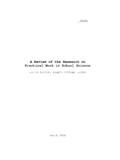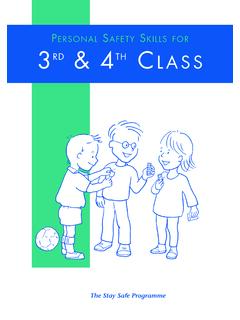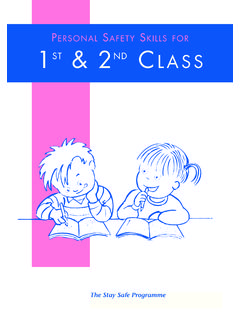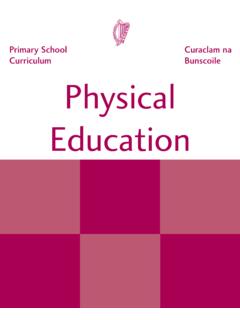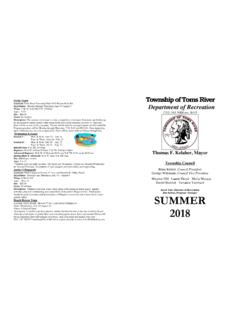Transcription of Practical Work in Primary Science - Score Education
1 Practical work in Primary Science Explore . Discover . Inspire . Foreword What do I really remember about doing Science at school? Making a cardboard aeroplane in physics, colourful and explosive experiments in chemistry, looking at the intricate structure of plants and bodies down a microscope in biology. Above all, Science is a Practical subject. Most of what we know about how the world works was discovered, not by sitting in a chair and thinking hard, but by getting hands-on: pulling things apart, putting them back together, testing out ideas. Practical Science is all about Photograph by Dave Pra tt learning by doing'.
2 Students achieve a deeper level of understanding by finding things out for themselves, and by experimenting with techniques and methods that have enabled the secrets of our bodies, our environment, the whole universe to be discovered. So brains on, hands on, get Practical ! Dr Alice Roberts Anatomist University of Bristol Practical work mirrors the pioneering investigative and exploratory nature of Science . Teacher response to Score questionnaire 1. Contents Introduction 2. Activity grids 4. General health and safety guidance 6. Primary level activities: Make friends with a tree: Living things 10.
3 Peace at last: Sound 13. Making sandcastles: Materials 15. Curtains: Light 17. Bone mystery: Living things 19. Design a seed: Living things 21. Paper towel magic: Materials 23. Bishops can fly: Forces 24. Colour mixing: Materials 27. Transition focus: examples of lower secondary activities: Biology No stomach for it: 32. Modelling the effect of antacid medication Biodiversity in your backyard: 34. Fieldwork using your school playing field Chemistry A matter of balance: The combustion of iron wool 42. Red cabbage indicator: Making a pH indicator 44. Physics Bolt from the blue: Timing a 100 m run accurately 48.
4 Feeling the pressure: 51. Investigating the effects of atmospheric pressure Further information 53. Biology Chemistry Physics 2 Introduction Hands-on learning experiences are valuable in helping students through key to the development of skills and the transition from Key Stage 2 to 3. the tying together of Practical and There is a wide range of possible theory. Good quality Practical work purposes for including Practical work can not only engage students with in Science lessons. Any particular the processes of scientific enquiry, piece of work should have its but also communicate the excitement purposes made explicit to pupils if and wonder of the subject.
5 They are to benefit fully from it. If not, This booklet has been designed there is a danger of pupils seeing to illustrate a range of reasons why Practical work merely as a break you might do Practical work , and to from the more routine activities of direct you to sources of high quality speaking, listening and writing. Practical activities for you to use in The activities chosen here illustrate your classroom. Whilst the focus a range of purposes and highlight of this booklet is Practical work in different types of Practical activity Primary Science , a few secondary level that could be used to teach various activities have also been included to topics in the Science curriculum.
6 The highlight the importance of transition. selections are purely illustrative and The lower secondary activities will be we recommend that you take a look useful for teachers in schools where at the original sources (particularly the age of transition is later than 11, ) for middle schools. Many Primary further examples, and use the directory schools enhance their curriculum at the back of the booklet to help you provision through links with colleagues find an activity to suit your needs. in secondary schools, and this can be 3. The experiments have been categorised into Lower Primary (age 4-7), Upper Primary (age 8-11), and Lower Secondary (age 12-14).
7 Often, however, activities can be adapted for use with more than one age group. The activities have also been categorised by purpose, and as you will see in the table, many of the activities fall into more than one category: Investigations including teamwork, Extended enquiry, Challenging existing ideas, Out of the classroom, Use of ICT, The messiness' of real data, Stimulating demonstrations, and Developing skills. We would encourage Science Coordinators to look at what is being offered in terms of Practical work within their own institutions and ensure that the full range of purposes are covered.
8 A blank table has been provided that could be photocopied and completed. Science without Practical is like swimming without water .. Teacher response to Score questionnaire 4 Activities categorised by level and purpose Investigations inc. teamwork The messiness' of real data Stimulating demonstrations Challenging existing ideas Out of the classroom Lower Secondary Extended enquiry Developing skills Lower Primary Upper Primary Use of ICT. Primary Science Make friends with a tree: Living things X X X X. Peace at last: Sound X X. Making sandcastles: Materials X X X X.
9 Curtains: Light X X X. Bone mystery: Living things X X X X X. Design a seed: Living things X X X. Paper towel magic: Materials X X X. Bishops can fly: Forces X X X X. Colour mixing: Materials X X X. Biology No stomach for it X X X. Biodiversity in your backyard X X X X X X X. Chemistry A matter of balance X X X. Red cabbage indicator X X X. Physics Bolt from the blue X X X. Feeling the pressure X X X X. Lower Primary Upper Primary Lower Secondary Investigations inc. teamwork Extended enquiry Challenging existing ideas Out of the classroom Use of ICT.
10 The messiness' of real data Stimulating demonstrations Complete this table with your own activities, and assess their purposes Developing skills 5. 6 General health and safety guidance See the health and safety notes in each experiment. The following is general guidance. Health and safety in school Science affects all concerned: teachers and classroom assistants, their employers, pupils, their parents or guardians, as well as authors and publishers. These guidelines refer to procedures in the United Kingdom. If you are working in another country you may need to make alternative provision.
